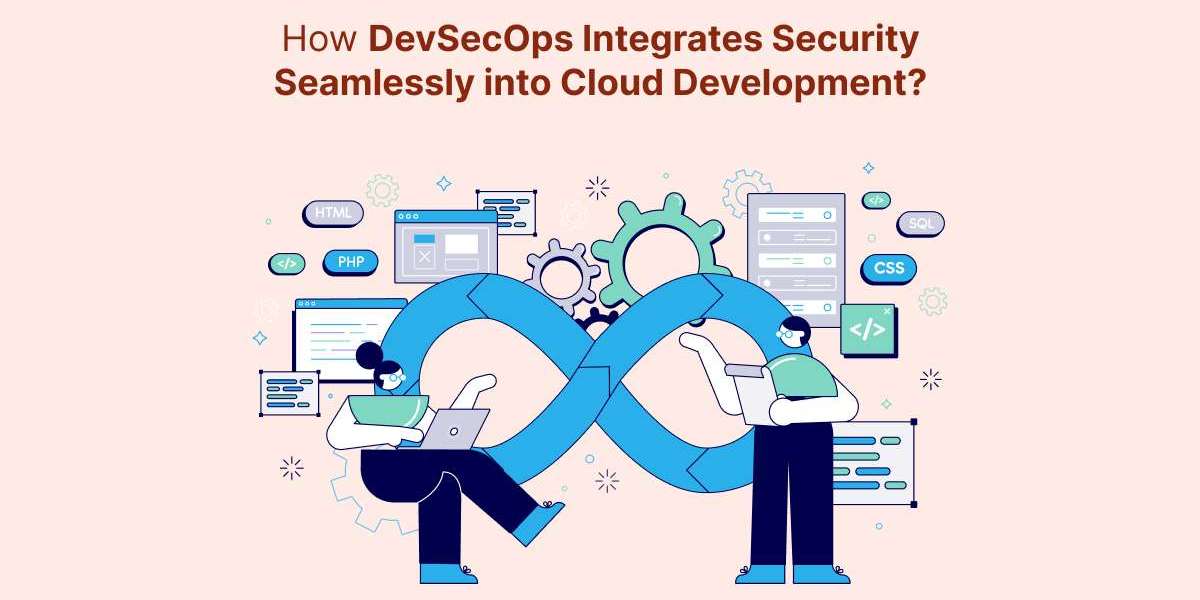Cloud computing has transformed the way businesses build and deliver software. It allows organizations to move faster, scale on demand, and innovate more freely. But with this agility also comes a higher risk of security threats. In the race to release features quickly, security can easily get left behind. That’s where DevSecOps plays a crucial role.
DevSecOps, which stands for Development, Security, and Operations, is a modern approach that weaves security into every stage of the cloud development lifecycle. Instead of treating security as a final step, it makes it a shared responsibility across teams. With DevSecOps, security is no longer a separate task handled by a different department—it becomes a continuous, integrated process.
In this blog, we’ll explore how DevSecOps makes cloud development more secure without slowing things down. We'll break it down in simple terms and show how this approach helps development teams deliver safer applications at speed.
What Is DevSecOps?
A Modern Mindset for Security
DevSecOps is more than just tools or automated scanners—it’s a way of thinking. In traditional development, security checks come at the end of a project. This approach often leads to last-minute delays, expensive fixes, or even missed vulnerabilities. DevSecOps changes that by embedding security practices into the development and operations process from the very beginning.
Why DevSecOps Is Needed in the Cloud
Cloud environments are fast-moving and highly dynamic. Developers push changes frequently, infrastructure is automated through scripts, and workloads scale up and down constantly. These benefits also introduce new security risks. DevSecOps addresses these risks by ensuring that every change—whether in code, configuration, or infrastructure—is reviewed and validated through automated security checks.
How DevSecOps Works in Cloud Development
Integrating Security into CI/CD Pipelines
In cloud development, Continuous Integration and Continuous Delivery (CI/CD) pipelines are essential for rapid deployments. DevSecOps injects security tools directly into these pipelines. This means that as developers write code, it gets automatically scanned for vulnerabilities. If something risky is found, the pipeline can stop the deployment until it's resolved. This creates a balance between speed and security.
Automating Code Analysis
One of the main benefits of DevSecOps is that it automates many tasks that were previously manual. Static Application Security Testing (SAST) tools scan source code as it’s written. These tools look for bugs, unsafe practices, or common vulnerabilities like SQL injection or insecure data handling. Because the process is automated, developers get instant feedback and can fix problems on the spot.
Securing Infrastructure as Code (IaC)
In cloud development, infrastructure is often created using code—this is called Infrastructure as Code. Tools like Terraform or AWS CloudFormation allow teams to set up servers, databases, and networks through scripts. While this makes deployment faster and more consistent, it also means a small error in the code could lead to security risks. DevSecOps includes IaC scanning tools that check for misconfigurations before they reach the cloud. For example, it can detect if a server is being launched with public access or if sensitive data is being stored without encryption.
Container and Kubernetes Security
Cloud applications often use containers and orchestrators like Kubernetes to manage workloads. These technologies bring flexibility, but they also introduce new security challenges. DevSecOps includes container image scanning, network policy enforcement, and runtime monitoring to ensure that only secure containers are allowed to run and that they operate in a controlled environment.
Policy as Code
Instead of writing down security rules in documents, DevSecOps turns them into code. This is called "Policy as Code." It ensures that security policies are consistently enforced across all environments. For instance, a policy might block deployment of any application that has open SSH ports or uses outdated libraries. These rules are applied automatically through the development pipeline, reducing human error.
Real-Time Monitoring and Logging
Security doesn’t stop once an application is deployed. DevSecOps includes real-time monitoring tools that watch for unusual behavior, failed login attempts, or unauthorized access. Logs are collected and analyzed continuously, giving teams visibility into the health and security of their applications. If something goes wrong, alerts are triggered so action can be taken quickly.
Read more: How DevSecOps Revolutionizes Cloud Security for Modern Businesses?
Benefits of DevSecOps in Cloud Development
Early Detection of Security Issues
When security is part of every step in the process, vulnerabilities are caught early—before they become bigger problems. This not only makes applications safer but also saves time and resources.
Faster Time to Market
Because security checks are automated and built into the development process, there’s no need to wait for separate security audits. Teams can move faster and release updates more frequently without skipping safety checks.
Improved Collaboration Between Teams
DevSecOps encourages developers, operations staff, and security experts to work together. This improves communication, reduces misunderstandings, and creates a culture where everyone is responsible for security.
Consistent Security Across Environments
Whether it’s a development, staging, or production environment, DevSecOps ensures that the same security policies are applied everywhere. This consistency reduces surprises and makes deployments more predictable.
Compliance Made Easier
Cloud applications often need to follow strict regulations, like GDPR, HIPAA, or SOC2. DevSecOps helps by automating compliance checks and providing audit logs, making it easier to meet legal and regulatory standards.
Real-World Example: DevSecOps in Practice
Let’s say a fintech company is developing a mobile payment platform using cloud services. Security is extremely important because they’re handling financial data. With DevSecOps, their team sets up a CI/CD pipeline that includes automated code scans and IaC validations. When a developer writes a new feature, the code is automatically checked for known vulnerabilities. Their infrastructure scripts are scanned to ensure databases are encrypted and only accessible from secure sources.
Before deploying, container images are scanned, and any with security flaws are blocked. Once the app is live, real-time monitoring tools keep an eye on unusual login patterns or traffic spikes. All logs are stored and reviewed regularly to detect potential threats. Because these practices are automated and part of the development workflow, the team can move fast without compromising on security.
Challenges of Implementing DevSecOps
Changing the Culture
One of the biggest hurdles in adopting DevSecOps is changing how teams think about security. In many companies, developers see security as someone else’s job. DevSecOps requires a mindset shift where security becomes part of everyone’s role.
Tool Overload
There are many DevSecOps tools available, and picking the right ones can be overwhelming. It’s important to choose tools that fit your tech stack and integrate smoothly with your existing systems.
Skill Gaps
Not all developers or IT staff are familiar with security practices. Training and upskilling are essential for DevSecOps to work. Teams need to learn how to write secure code, manage cloud infrastructure properly, and respond to incidents effectively.
Balancing Speed with Security
Sometimes, adding too many security checks can slow down development. The key is finding the right balance. DevSecOps aims to make security seamless—not a roadblock—by using smart automation and prioritizing critical risks.
The Future of DevSecOps in Cloud Development
As technology evolves, DevSecOps will continue to grow. Artificial intelligence and machine learning will make security tools even smarter, allowing them to predict threats before they happen. More companies will adopt DevSecOps as a standard practice, not just a trend. In the future, security will be completely embedded in every part of the development process, from idea to deployment. Organizations that adopt this model early will be better prepared to face the growing complexity of the cloud.
Conclusion
Cloud development is all about speed, flexibility, and innovation. But these advantages come with their own set of security risks. DevSecOps offers a way to enjoy the benefits of the cloud without compromising on safety. By integrating security directly into the development process, it helps teams build more secure applications while still moving fast. From automated code scans to infrastructure validation and real-time monitoring, DevSecOps ensures that security is always present but never in the way. For any app development company, adopting DevSecOps is not just a smart strategy—it’s a necessity for building trust, ensuring compliance, and staying ahead in today’s digital landscape.
FAQs
What is the main goal of DevSecOps?
The goal of DevSecOps is to integrate security into every part of the development and operations process, making it a shared responsibility instead of an afterthought.
How does DevSecOps help with cloud development?
It automates security checks, monitors infrastructure, and enforces policies, ensuring that cloud-based applications are safe from vulnerabilities without slowing down development.
Can DevSecOps be used with any cloud provider?
Yes, DevSecOps practices are cloud-agnostic and can be used with providers like AWS, Google Cloud, Azure, or any other platform that supports modern DevOps tools.
Do developers need to be security experts to adopt DevSecOps?
Not necessarily, but they should have basic knowledge of secure coding practices. DevSecOps tools provide guidance and automation to help developers write safer code.
Is DevSecOps suitable for small teams or startups?
Absolutely. Even small teams can benefit from DevSecOps by using lightweight tools and automating key security tasks early in the development cycle.




